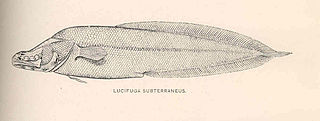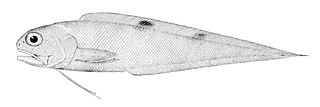Ophidiiformes is an order of ray-finned fish that includes the cusk-eels, pearlfishes, viviparous brotulas, and others. Members of this order have small heads and long slender bodies. They have either smooth scales or no scales, a long dorsal fin and an anal fin that typically runs into the caudal fin. They mostly come from the tropics and subtropics, and live in both freshwater and marine habitats, including abyssal depths. They have adopted a range of feeding methods and lifestyles, including parasitism. The majority are egg-laying, but some are viviparous.

The cusk-eel family, Ophidiidae, is a group of marine bony fishes in the Ophidiiformes order. The scientific name is from the Greek ophis meaning "snake", and refers to their eel-like appearance. True eels, however, diverged from other ray-finned fish during the Jurassic, while cusk-eels are part of the Percomorpha clade, along with tuna, perch, seahorses, and others.
Aphyonidae is a family of eel-like fishes in the order Ophidiiformes. They are found in tropical and subtropical waters throughout the world. They are deep-sea fishes, living between 2,000 metres (6,600 ft) and 6,000 metres (20,000 ft) depth.

Lucifuga is a genus of viviparous brotulas. Most of the species are native to caves and sinkholes in Cuba and the Bahamas; L. inopinata from deep water off the Galápagos Islands is the only exception. The four species rated by the IUCN are all considered vulnerable. The largest species in the genus reaches about 15 cm (5.9 in) in length.

Ogilbia is a genus of viviparous brotulas. The generic name honours the Australian naturalist James Douglas Ogilby (1853-1925), for his contribution to the knowledge of the fishes of Australia.

Saccogaster is a genus of viviparous brotulas. They are found in the western Atlantic and Indo-Pacific.
Bellottia is a genus of viviparous brotulas which is found in the subtropical waters of the North Atlantic, the Mediterranean Sea and the Indo-Pacific.

Bidenichthys is a genus of viviparous brotulas.

Hephthocara is a small genus of Indo-Pacific viviparous brotula.
Bassogigas gillii is a species of cusk-eel found in the Indian, Pacific Ocean, and Atlantic Oceans at depths of from 637 to 2,239 metres.
Bassogigas is a genus of cusk eel from the subfamily Neobythitinae, part of the family Ophidiidae. The generic name "Bassogigas" comes from a combination of two Latin words: bassus, which means "deep" and gigas which means "giant". The species are found in the Indo-Pacific and western Atlantic Ocean.

Monomitopus is a genus of cusk-eels. They are oviparous.

Neobythites is a genus of cusk-eels.

Sirembo is a genus of cusk-eels of the subfamily Neobythitinae, family Ophidiidae, which are found in the Indian and Pacific Oceans. The species in this genus have a rather robust body with the dorsal fin originating over vertebrae 1–5. The head and bod are completely covered in scales, they have large eyes which are almost equal in diameter to the length of snout, the pelvic fins have two rays which are joined together within an area of tough skin, They have a short spine on the operculum which does not extend to the posterior edge of the head. Their coloration is variable but almost all species have black spots or eyespots on the dorsal fin, sometimes both, while the middle part of the anal fin frequently has a black band. The body and/or head are marked with diagonal or horizontal dark stripes or horizontal rows of quite large dusky spots.
Paraphyonus is a genus of blind cusk eels found in the Atlantic, Indian and Pacific Oceans. This genus was created for species formerly classified under Aphyonus when sampling of specimens showed that the type species of Aphyonus, A. gelatinosus, was not closely related to the other known species in the genus, including the newly identified species P. iselini and P. merretti. This work also brought Barathronus solomonensis into the new genus. The result of this classification is that Aphyonus would be a monotypic genus.
Brotulotaenia brevicauda is a benthopelagic marine fish species in the family Ophidiidae. This totally black fish is usually found in the Atlantic Ocean but it has also been reported in the Indian. B. brevicauda lives in deep water and grows up to 32 cm in length. It is also occasionally known as the Short-tail cusk-eel.

Brosmophycinae is a subfamily of the viviparous brotulas. They are divided from the subfamily Bythitinae by having the dorsal fin, caudal fin and anal fin all separate whereas they are joined in the Bythitinae. It is divided into the tribes Dinematichthyini and Brosmophycini, with the first having hardened genital claspers and the second soft genital claspers. A review in 2016 elevated the Dinematichthyini to the status of a family the Dinematichthyidae.

Brosmophycini is a tribe of viviparous brotula, one of two tribes in the subfamily Brosmophycinae. They are distinguished from the other brosmophycin tribe, the Dinematichthyini, by having a male intromittent organ which has no ossified parts, a scale-covered body and well developed gill rakers.

Bythitinae is a subfamily of viviparous brotulas, one of the two subfamilies in the family Bythitidae. This subfamily is characterised by having the dorsal, caudal and anal fins combined. They are mostly found in temperate to tropical seas, from reefs to the benthopelagic zone, but some species from the North Atlantic Ocean occur in into Arctic waters.
Bythitoidei is a suborder of the order Ophidiiformes, the cusk eels. They are distinguished from the other Ophidiform suborder, the Ophidioidei, by being largely viviparous.










